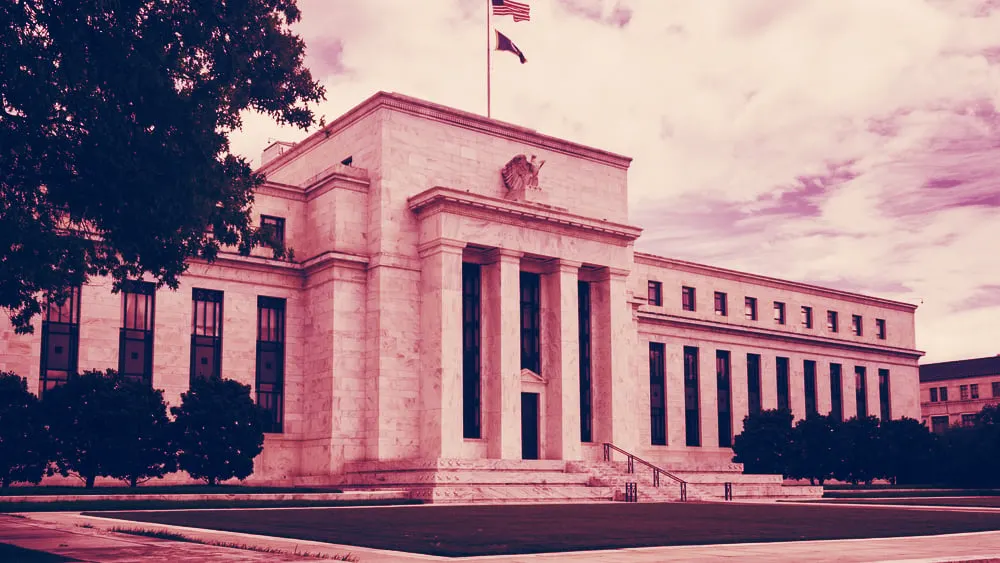In brief
- Bitcoin represents a tiny fraction of the $19.4 trillion US dollar circulating supply, but its market cap continues to grow.
- Were it to challenge the status of the US Dollar, the Federal Reserve would struggle to seize control of Bitcoin.
- Attempting to add Bitcoin to its reserves would likely boost the value of Bitcoin and start a race with other countries' central banks.
Bitcoin (BTC) has been called many things: digital gold, a store of value, and a currency—indeed, it’s now the fifth-largest world currency when its market capitalization is compared to the M0 money supply of fiat currencies.
Of course, it’s still small potatoes when compared to the US Dollar, the world’s reserve currency. At its current market capitalization of ~$915 billion, Bitcoin represents just a tiny fraction of the $19.4 trillion US dollar circulating supply. However, given that Bitcoin's market capitalization has multiplied around 55-fold in the last four years and over 100-fold in the last seven, it isn't an unrealistic projection to imagine it could one day rival that of the US Dollar.
And the US Federal Reserve is certainly aware of Bitcoin; its Chairman, Jerome Powell, has described Bitcoin as “a speculative store of value like gold,” in the past, noting that “almost no one uses it for payments.”
Given that the US Federal Reserve holds just over $44 billion in foreign currencies, what's stopping it from adding Bitcoin to that list? There are a number of reasons why it won't—or simply can't.
It could be counterproductive
First off, Bitcoin still has a long way to go before it's considered worthy of the Fed's attention. Nimrod Lehavi, co-founder and CEO of Simplex, believes that Bitcoin likely isn't on the Fed’s radar just yet. "There need to be more publicly-traded companies who buy crypto before the Fed will begin to even consider purchasing and holding Bitcoin," he told Decrypt.
Although Tesla's $1.5 billion Bitcoin buy in February 2021 sparked a flurry of interest in Bitcoin among institutional investors, the cryptocurrency still has a long way to go before it's trading at a level where the Fed would take notice. “Until Bitcoin begins trading roughly at parity with the US dollar in terms of trading volume, the Fed is unlikely to consider it as a threat.”
Because the price of Bitcoin is largely driven by changes in supply and demand, were the Fed to buy some Bitcoin, both retail and institutional investors would likely catch on and begin stockpiling Bitcoin themselves. This, in turn, could end up causing a dramatic sell-side shortage, reducing the supply and potentially driving up the demand for whatever is left; in effect, a massively-amplified version of what happened in late 2020 as institutional investors hoarded Bitcoin.
Depending on how the market responds, this could drive the price of freely circulating Bitcoin up by such a degree that the circulating market cap matches or exceeds its value before the Federal Reserve intervened—the exact opposite of what the Fed might want.
“From an optics point of view, it may promote the wrong message if the Federal Reserve was to buy Bitcoin, given that this asset was created to challenge governments and centralized control of global currencies,” Simon Peters, market analyst at eToro, told Decrypt.
"From an optics point of view, it may promote the wrong message if the Federal Reserve was to buy Bitcoin."
Why might the Fed buy Bitcoin?
There are two main reasons the Fed might want to buy up Bitcoin. The first is to gain majority control over what it believes to be the world's next reserve currency, whereas the second is to drive its value down to maintain the status of the US dollar as the world's reserve currency. As we'll soon see, buying Bitcoin for either of these two purposes will likely have unintended consequences—and would, more likely than not, prove to be counterproductive.
In order for the Fed to control Bitcoin as a reserve currency, it would need to acquire and control the distribution and movement of the majority of Bitcoin. However, the Fed would likely be in competition with the central banks of several other countries, since it would be a strong indication that the Fed believes Bitcoin is a powerful asset. Depending on the will and buying power of other countries, the Fed might end up with the short straw.
Nevertheless, it may have to move sooner rather than later. In October 2020, it emerged that Iran may be looking to funnel Bitcoin and potentially other cryptocurrencies into its reserve after it was revealed that the country's legally registered cryptocurrency miners were required to sell their cryptocurrencies to the Central Bank of Iran (CBI)—likely at below-market rates.
The State of the Reserve
As per the most recent official reports, the United States’ reserve is comprised of $144.89 billion worth of assets, the largest chunk of which ($52.9 billion) is held as special drawing rights (supplementary foreign exchange assets), while the second-largest chunk ($44.5 billion) is held as foreign currencies—mostly Chinese yen (CNY), euros (EUR), and Pound sterling (GBP).
Even if the United States converted all the assets in its reserve to Bitcoin, it would still control less than half of the Bitcoin in circulation. Or more realistically, if the Federal Reserve made Bitcoin its biggest holding (replacing special drawing rights), it would hold just 17.2% of the Bitcoin circulating supply—far too little to have a major influence on how the cryptocurrency is used by other countries, businesses or individuals.
Given that Bitcoin mining is essentially free game in the United States, and there is no established pipeline to direct newly mined Bitcoin straight into Fed’s coffers at a favorable rate, it would likely be forced to buy Bitcoin either from public exchanges or OTC desks at market price. With no way of ensuring priority access to Bitcoin, the Fed could find it difficult to secure large quantities of BTC without driving up external demand for the cryptocurrency—further undermining its efforts to build its Bitcoin reserves.
Total control of Bitcoin is unfeasible
While it may be technically feasible to buy up some or even the majority of Bitcoin sold on open exchange platforms and over-the-counter (OTC) desks, the United States is unlikely to settle for anything but near-total control of the cryptocurrency—this would entail buying up the majority of all Bitcoin in existence, and then maintaining this control as new Bitcoin are minted.
However, this may be an unfeasible challenge, since a large proportion of Bitcoin is locked away for a wide variety of reasons, and may never end up traded or sold on public platforms.
For one, around 3.7 million Bitcoin may be irretrievably lost, whereas an unknown further amount of Bitcoin is locked for varying periods of time using one of the various timelock smart contract primitives—which can be used to restrict access to Bitcoins until a set date.
In addition, more than 10% of the Bitcoin total supply has yet to enter circulation, and will gradually be released with each new block mined through the mining reward process.
While the Fed may be able to purchase a large chunk of the coins that reach open trading platforms, stiff competition from other countries, institutions, and individual investors make it unfeasible that the Fed could achieve majority control—especially when you consider that Chinese miners currently control almost two-thirds of newly minted Bitcoin.
The Bitcoin Standard
Under the assumption that Bitcoin would maintain its market capitalization through this Fed purchase process, it would take decades for the Federal Reserve to build a substantial Bitcoin balance—since the Fed currently has an annual operating budget of just $4.77 billion as of 2020.
"It is not easy for the Fed to admit Bitcoin is the ultimate solution for the Fed’s expansionary policy, excessively supplying dollars to the market and elating the value of the dollar."
There are two ways it could potentially expedite this process. The first and simplest way would be to dramatically increase Fed spending, allowing it to increase the rate at which it purchases Bitcoin from open and private markets. The second option would be to set and enforce a fixed exchange rate for USD to BTC; it could even go so far as to prohibit owning more than a fixed amount of Bitcoin, similar to when Franklin D. Roosevelt signed Executive Order 6102, forbidding the hoarding of gold during the Great Depression.
However, this could lead to the formation of a black market exchange rate, similar to that seen in Venezuela and Iran due to their capital controls, and could signal a lack of faith in the US Dollar—further driving the incentive to hoard Bitcoin.
Could local municipalities lead the way?
Although it is unlikely that the Federal Reserve will add Bitcoin to its coffers any time soon, the same can’t be said about local municipalities—many of which have already mulled over either investing in Bitcoin or accepting Bitcoin for local services.
This includes the City of Miami, whose governing commission recently passed a resolution from Mayor Francis Suarez, which could eventually allow City of Miami employees to receive part of their salary in Bitcoin and pay their taxes using BTC.
Mayor Francis Suarez also recently tweeted that the City of Miami would begin analyzing the possibility of using its treasury reserves to invest in Bitcoin—which means the City of Miami could be the first example of a local government using state money to invest in cryptocurrencies.
Exploring:
• State legislative priority
• Paying employees in Bitcoin
• Investing City treasury in BitcoinWe got it done ✅ pic.twitter.com/88laGvVbEG
— Mayor Francis Suarez (@FrancisSuarez) February 12, 2021
A February 5 report by the Federal Reserve Bank of St. Louis—one of the 12 banks that make up the Federal Reserve—also revealed that it has been keeping tabs on the burgeoning decentralized finance (DeFi) space. The report revealed that the St. Louis Fed is fully aware of the benefits it can offer over legacy financial systems—namely lower costs, and improved speed and transparency.
Though DeFi is a largely Ethereum-based affair right now, the rapid proliferation and adoption of cross-chain technologies like Polkadot, Cosmos, and token-wrapping protocols has seen assets from an increasing number of blockchains folded into the realm of DeFi—including Bitcoin via Wrapped BTC (WBTC) and similar assets.
As a result, the adoption of public DeFi technologies would likely lead to the adoption of Bitcoin (BTC)—albeit indirectly. But whether or not this paves the way for adoption or investment in BTC at the federal level would likely hinge on the success of these early experiments.

